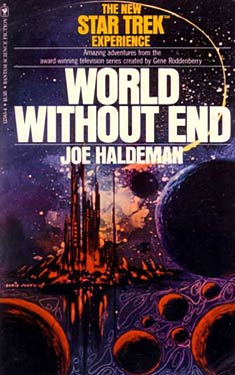GMRC Review: World Without End by Joe Haldeman
 On his blog Stainless Steel Droppings blogger Carl V. Anderson reviews SF/F books and movies, conducts author interviews and even hosts his own reading challenge: The 2012 Science Fiction Experience. This is Carl’s third GMRC review.
On his blog Stainless Steel Droppings blogger Carl V. Anderson reviews SF/F books and movies, conducts author interviews and even hosts his own reading challenge: The 2012 Science Fiction Experience. This is Carl’s third GMRC review.
After a month of benchmark tests Captain James T. Kirk is bored. He laments the lack of “action”, something the crew silently disagrees with. As things are wont to happen in the Star Trek universe, Kirk soon gets the action he seeks in the form of the discovery of an ancient generation ship, a Bussard ramjet-powered vessel in the shape of a large planet. Scans indicate that roughly a million lifeforms live within this spherical planet that has been traveling for roughly 3,000 years. The Enterprise crew also discovers that the ship is in its braking phase and will eventually end up in a location that could not have originally been planned, for it will cost everyone on board their lives. So what is a Federation crew to do? Why beam down into the planet, of course!
After a test to ensure that the transporters will function properly, Captain Kirk, Dr. Leonard “Bones” McCoy, and a small team beam inside the planet only to discover that the metal which encases this ship will not allow them to beam out. With the use of their language translator they soon make contact with the natives, a roughly humanoid species that can fly thanks to membranous wings. This race, the Chatalia, have no knowledge that they are inside any kind of ship, label Kirk and crew as ‘magicians’ and ‘blasphemers’, and take them captive. Circumstances mount upon circumstances and the crew within this world as well as those remaining in the Enterprise soon find themselves in a race against time for their very survival. For the Chatalia have met beings like humans before, beings arrived in violence and murdered many Chatalia before finally being subdued. And it just so happens that the Federation crew is very familiar with the people the Chatalia believe them to be a part of… the Klingon Empire.
Throughout the novel there is evidence of Haldeman‘s strengths as an author. First off he wastes no time “introducing” these characters. By 1979 the cast of the original Star Trek series were well known to the fans. Instead he reveals his solid knowledge of who these characters are by their actions and dialogue which are spot on, especially for Kirk, Spock and McCoy. One of the treats of the original series is the banter between Spock and McCoy and here it is done to perfection. The humor is wry and present in just the right measure to entertain without any degree of overkill. Haldeman avoids many of the things that are now cliche in Star Trek stories, including the inevitable demise of any “redshirt” crew members. Much of the focus is on the caste system of the Chatalian peoples, including a very interesting custom in which members of different classes speak different languages and only communicate with other classes by means of an interpreter. Haldeman builds a complex world system, works in ideas of cloning and advanced intelligence, and throws in a measure of “science”.
 Where the novel stumbles is in its attempt to do too much in too little space, something that I actually give Haldeman credit for trying to pull off. In the end the length of the novel (148 pages) inhibits some of the storytelling because situations have to be resolved quickly. In that respect it actually has some of the same structural flaws as trying to fit a complex adventure into an hour television block (less when factoring in commercials). That does not keep the novel from being entertaining. Three simultaneous storylines: the crew in the planet, the crew on the Enterprise, and a crew of Klingon warriors make for an exciting story, coupled with Haldeman’s skill in rendering characters that are beloved to many make for a novel worth reading.
Where the novel stumbles is in its attempt to do too much in too little space, something that I actually give Haldeman credit for trying to pull off. In the end the length of the novel (148 pages) inhibits some of the storytelling because situations have to be resolved quickly. In that respect it actually has some of the same structural flaws as trying to fit a complex adventure into an hour television block (less when factoring in commercials). That does not keep the novel from being entertaining. Three simultaneous storylines: the crew in the planet, the crew on the Enterprise, and a crew of Klingon warriors make for an exciting story, coupled with Haldeman’s skill in rendering characters that are beloved to many make for a novel worth reading.
To summarize: In this, Haldeman’s second Star Trek novel, he demonstrates a deft touch in capturing the essence of these characters while crafting an adventure more complex than what Roddenberry and company could manage in a one hour television show. The novel stumbles at times, mostly due to the attempt to combine intricacy in plot and brevity in novel length, but overall it is an entertaining volume in the lore of Captain Kirk and the starship Enterprise.



















 Full Details
Full Details



5 Comments
I’m glad to hear there are good Star Trek books out there! I bought the 12 volume Blish series, in mint condition, with much anticipation and they were so bad I couldn’t read them. Juvenile retellings of the television episodes. At least they look good on the shelf 😉
I’ve heard that about the Blish books. I own one that I bought because I loved the cover, and another that was given to me (also with a great cover) that was signed by DeForest Kelley. I’ve certainly read some really good Trek books over the years. My favorite is Prime Directive by Judith Garfield Reeves-Stevens. I’ve also enjoyed the first book in the Vanguard series, Harbinger by David Mack. I’ve actually collected that whole series now and am wanting to dive back into them. As much as I like many of the Star Trek series, I prefer original series novels.
Great job with the pics, by the way. I like seeing Haldeman’s image in there.
I read all the Star Trek books that came out during the ’70s, but none since. I don’t have any of those books anymore, but I do remember this as being one of the best, though it wasn’t until I saw this review that I realized who the author actually was. I never connected the Haldeman of Forever War with the guy who wrote those Trek novels I read as a kid! The Blish adaptations were pedestrian, but they came out in the pre-home video days, so they were the only way to revisit the episodes without waiting for them to show up on the afternoon reruns. For that reason, they seemed pretty cool at the time. I seem to remember that, oddly, the Alan Dean Foster adaptations of the animated series were more interesting. He managed to squeeze ten books out of twenty or so half-hour episodes, expanding a lot on the scripts. Thanks for the review; it brings back a few memories!
I hadn’t thought about that in regards to the Blish books Scott, which I am kicking myself for because I like to try to consider things in their historical light. That is a very good point. As a kid I read and re-read the Star Wars novelizations. I doubt anyone could consider them great writing, but it was the only way to "see" Star Wars again in those pre-video days. In that light the Blish books were probably valuable to many of the fans. I bought this book cheap because I liked the cover and I hadn’t made the Haldeman connection either until I saw it in the basement the other day. I did a double take and decided I better go ahead and move it up the pile. Glad I did.
Sorry, the comment form is closed at this time.